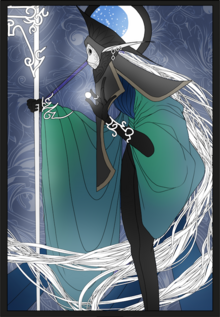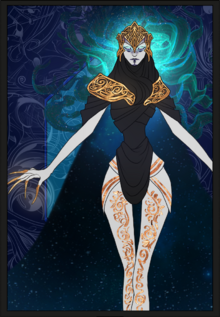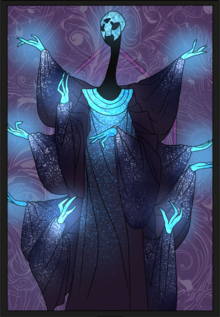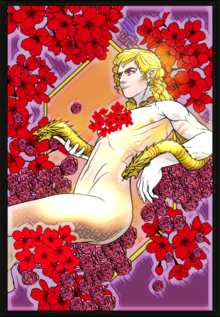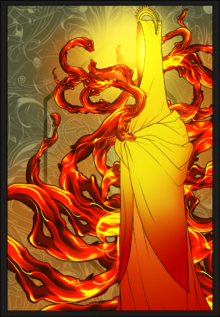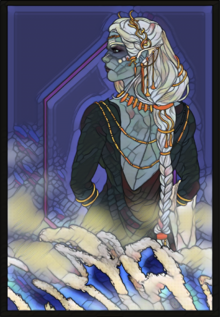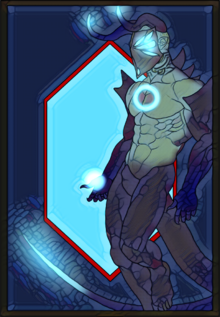Estelley
THIS PAGE IS OBVIOUSLY A WORK IN PROGRESS
| Estelley | |
|---|---|
 | |
| Religion | |
| Pronunciation | Estel-lei |
| Origins | 15,000 years ago. |
| Deities | |
| 10 unified Gods. | |
| Subsects | |
| Regional interpretation differences. | |
Origins
Estelley is rooted in the history of the Elven Races, even though its followers do not all belong to that people. It is understood that early Elven history played host to a patchwork of bronze-working kingdoms in a strange world far unlike the modern one, murals depicting lanky and alien-looking long-eared mortals doing business with the Dewamenet, the similarly oversized, though muscular ancestors of the Asha, and a whole range of other cultures that have since been erased from Aloria. Each kingdom tended to favor a single patron god, the divinities bickering and fighting like the people did, until Estelley's first prophetess Talea swept through like a wildfire conquering throne after throne and uniting the Gods she went under the dogma of the over-deity Estel, a sleeping creation goddess. Talea's divine right was proved at the tip of her spear and down the barrel of her spellcraft: uniting the Elves into the first iteration of Estelley dogma, recorded on a variety of stone slates and obelisks meticulously handed down. While Estelley is associated with Exist Magic and the powers of that Dimension due to Estel's lordship over it, they have a more complex understanding of their own Gods. While the Void and Ordial Gods had to sign bargains with other entities to escape their own Dimensions into Aloria's reality, the Estelley Gods were always native to the mortal plane and came into their arcane powers later, as a gift from Estel through Talea in a single mystery-shrouded event called "the Convergence". The Convergence is tied to the similarly murky Elven-Dewamenet War, which ended in that people's subjugation and enslavement: and so it is unlikely that a clear answer will ever be passed down about what the Convergence was or what it entailed, even from the lips of the Gods themselves.
Since Talea there have been two more prophets, no less important than she. Second was her younger brother Sanraan, who after the destruction of the Dewamenet cursed the Allorn victory as a defeat and proclaimed that an Empire built on poison would not last, and third was her youngest brother Fenhellëy who wrote the codes of governance and proper rule, also beginning the tradition of favoring Leyon as Estelley's highest god that would eventually become dominant outside the Allorn Empire. There have been no major modifications to Estelley dogma since the time of Fenhellëy, a boon and a curse at once. For while Estelley worshipers can claim with confidence that they have the most unedited and accurate religion to the exact practice of their forefathers, their faith's inability to change has often led to its defeat in its struggle against the usurping religions that have challenged it throughout history. Estelley is still one of the world's most popular religions practiced by a large range of cultures, and has a presence in most major states.
Core Beliefs
Estelley preaches that the world was created inherently flawed, and that it is the Estelley Gods who shall lead the people closer to perfection so that Estel might, when the last sinner disappears from Aloria, remake it in her divine image and merge the realms of the living and the dead. It does not deny the strength of divinities from other religions, such as Unionist Divines or even its hated enemies the Void Gods, but believes that they were created to lead mortals astray. Each Estelley God has a different role to play in bringing about this perfect world, and while priests and written dogma are allowed to be incorrect, the Gods are considered infallible in all cases. This has led to complicated situations where two opposed Estelley Gods have given contradictory instructions to the faithful, but with the overall understanding that different instructions can be valid at different times, and both still have their uses. Since Estelley has been around and prominent for so long, it is usually cast as the dominant traditional religion fighting back against upstart new dogma, to mixed success.
Standards of Perfection
Estelley does not have a formal set of Vices and Virtues, but rather so-called Standards of Perfection. Standards of Perfection are general life-goals and ambitions the faithful should strive towards. Once they feel confident they have met the Standard, they seek out Estelley Priests and undergo the Trials of Preparation, where the priests trial their perfection, sending them back to learning if they fail, and giving them a blessing and official recognition to their Ascendance. Estelley Faithful as such go through life seeking Ascendances, with most faithful having completed several Ascendances by the time they reach advanced age.
- Melca's Standard of Perfection is foresight to understand the troubles of the age, and to be well-informed and properly prepared for all eventualities that might arise.
- Leyon's Standard of Perfection is both having the strength and endurance to protect one's self, but also to protect others around one's self, even for no benefit to self.
Exist Arken
Arken are powerful beings of Magic who each embody a single idea, some created from Exist Magic, some from Void Magic. Many religions name them Demons and enemies, such as Dragon Worship and Unionism, while others raise particular Arken to Godhood, such as Fornoss which favors the Void Arken. Estelley does neither. Rather, it casts particular Exist Arken as heralds to their Gods, vested with a majority of their power as emissaries of their will and given the divine charge to protect their worshipers where they are unable to and enforce their power in the world. In the Allorn period there were seas of hundreds of named and known Arken strong enough to serve this role, with individual Estelley deities maintaining whole hosts of Arken allies, but in the modern day the death or absorption of many Arken has led to only three remaining: Justice who serves Leyon as a Lanlath named Artarel, Compassion who serves Mana as a Maquixtl named Ischel, and Beauty who serves Sapphora as a Fin'ullen named Vernaela. Just how much of their masters' divine power these so-called Heralds wield at a time is unclear, but Justice's ability to combat Void Arken revered by others as Gods suggests that it is more than one might initially assume. Unlike the Estelley Gods, Arken are not considered infallible. Even if they are Heralds, their orders can be refused without committing blasphemy or sacrilege.
Merjan
The Estelley afterlife is a very real and tangible thing. Called Merjan, a place-name as if it were just another principality or place that one could charter a carriage to, it is reached at the end of one's life by a ferry taken down the "straight river" by the death god Ammuloa. On one's way down the straight river, they relive their life over and over and over again as a series of disjointed flashes of moments or important events, given the opportunity to reflect on past ills done to others or suffered done to the self. Especially important is the moment of death: Estelley worshipers are very afraid of dying in bad circumstances or alone or of disease, because it might haunt them for decades as they journey to the afterlife. Past a series of gates guarded by Leyon, the souls of the Estelley dead dwell in Merjan's fair halls and await paradise to be achieved in the world of the living so that it might be united with theirs in perpetuity. This situation is moreover complicated by the Lanlath race, who dwell in a series of pocket dimensions under the protection of Leyon. Many theorize and understand that since Leyon controls both the afterlife and the dwellings of the Lanlath, that the Lanlath in fact live in the outer layers of Estelley heaven and serve as a sort of security buffer between the mortal world and the souls of the dead, with the physical gateway to Merjan somewhere in one of the more secret Lanlath realms that even they themselves have not been able to devise.
Gods and Goddesses
Estelley recognizes that all Gods are real and all Gods are infallible, but also stresses that not all Gods are infallible in the moment of their instruction. What this complicated idea means can be explained through the example of Cemaan. Cemaan's lessons preach the virtues of violent conquest and slavery for the Estelley faithful to ensure their survival in the world, a message which is rejected by the Lanlath and Maquixtl among others. In rejecting Cemaan's lessons, they don't claim that Cemaan is un-divine or that she is necessarily wrong that conquest has its benefits for those on the winning side, but that Cemaan is choosing the wrong era to tell the Estelley faithful to destroy and subdue their enemies, and that there will come a time when their survival is truly threatened and Cemaan will arise to save them. The distinction is that they are able to say that that time is not now, and they are therefore not going to listen to Cemaan now, but that does not involve degrading her godhood.
|
|
|
|
|
|
|
|
|
|
Priestly Activities
priests are called ordvaan and they are well respected and anyone can be one but there is a hierarchy if you want to be recognized. haphazard hierarchy of priests. there is no elf pope but there are a few elf cardinals
General Priesthood
see above
Mana Trees
awesome grove to chat and teach people at. do not let anyone burn it. im looking at you, kathar. im looking at you.
Layelarya
tell some stories from the elven religious books. or elven history maybe. that's a good time
Raelye
compliment session where you big up your flock of worshipers a bunch
Kathira
Collective punishment of a sinner by the Estelley faithful is called Kathira, or the "destruction of pride," the same root word that named the Kathar culture. The faithful form up into two long columns between which the accused must walk while the priest standing at the head of one of the lines recites their crimes for all to hear, with each worshiper in the line stating their own personal grievances and then striking the accused with a hand. Kathira can range in severity from a purely demonstrative ceremony meant to humble someone or even an ironic party trick performed purely in jest on someone whose virtue is beyond reproach with ridiculous accusations like having taken the last pastry, to a serious vigilante punishment where the punches are meant to bruise and disorient and the accused is brought near to collapse by the end of the line. While Estelley scripture prescribes that all wounds between the accused and the accuser are healed after this ceremony is performed, this very rarely if at all holds up in reality, and the punished almost always come back with a group of their friends to inflict violence on those who issued the punishment. As such, it is recommended and understood by most priests that Kathira is only to be performed on those who wish to show penance and will take its outcome seriously.
communal void worshiper clubbing and roasting session where you make them walk down a long gauntlet of estel people
Isantha
caroling. write a song and everyone takes turns singing a verse. very neat
Peripheral Concepts
Peripheral Concepts are important thoughts from Estelley theology, that didn't necessarily fit anywhere else on this page, but also aren't strictly necessary to know. They cover a wider range of topics which Estelley believers have a solidified opinion of, or things that Estelley faithful might get questioned on in Roleplay and may be useful to have answers for.
Prophets
Estelley recognizes three prophets: Talea, Sanraan, and Fenhellëy, in this order. Each of them has a separate holy book that together form the three-part Estelley religious canon, with successive priests over generations doing their best to curate statements and minimize contradiction, though sometimes to little success, as Talea and Sanraan were bitterly opposed in life. Talea's dogma is quite warlike and brutal, as the Elves in her lifetime were disunited and had to be brought together by the sword. Far from the ethereal wise ones that they are today, the Elves of Talea's rule were a backwards, folkish, and unlearned people who needed a strong hand to unify into a centralized state. The prophetess herself favored Cemaan and cast her as the focal point of the Estelley religion, a traditionally Allorn viewpoint, but one that would later be subverted by those who dwell outside the Allorn Empire. Her younger brother Sanraan fought with her in what he considered the defense of the Elven people until he witnessed the divine intervention of the Estelley Gods to destroy the Dewamenet in order to save the early Allorn nation from complete destruction: witnessing what is described in apocalyptic terms as the "extinction of a continent, ground rotting under a sea of white chalk," he turned away from his sister's cause and seceded with the people who would later become the Suvial culture. Sanraan's dogma is compassionate and regretful, reminding the faithful that a poisonous victory can never last, and that building an empire on slavery, extermination, and oppression is like raising a castle in a field of clay, dooming it to slowly sink. Their youngest brother Fenhellëy spent the majority of his life as an unimportant clerk, before composing a series of treatises on proper rulership considered so well-worded that they must have been divinely inspired, and made the final part of the Estelley canon only after his death. Fenhellëy emphasized Leyon worship in his writings as the most important part of the Estelley religion, as it is Leyon who provides the benevolence and grace necessary for a continuity of stable civilization, and his virtues which create the longest lasting empires. Leyon worship however did not catch on as a dominant role until the time of the Lanlath's secession from the Allorn Empire, covered on the Lanlath culture's page.
Vaalya
Vaalya, meaning "regnance," is the Elven idea that only one mortal Empire at a time can claim rulership or dominance of the world. Beginning as the Dragon Worshiper concept of the Mantle of the World, the idea that Dragons created all things and passed the responsibility to steward them on to the living, this concept changed significantly over millennia of interpretation. Vaalya proposes that pluralism of ideas and difference of opinion is false, and all opposing dogma is somehow a flawed or incomplete version of Estelley dogma in the light of which worshipers were led astray. This concept is dominant even among more benevolent Estelley worshipers, leading to the arrogant and patronizing air that Elves are famous for, the idea that they stoop in their grace to uplift barbarians who do no not know better. As much as it seems an oppressive ideology to follow, there is some truth to this idea. For the Dewamenet Empire to arise the Meraic had to collapse, and for the Allorn Empire to achieve glory it had to destroy the Dewamenet, while the modern Regalian Empire is in turn built on the corpse of the Allorn Empire, sure to someday follow it and be replaced by something else. Not entirely about the correctness of Elves, it also proposes that this one dominant ideology always cycles and that power never lasts, a shifting and impermanent system where no legacy is truly meaningful except for those remembered by the people.
Worthiness
magic is very cool but if you are not a badass we will laugh at you non elves are no less cool than elves but you have to buy into the bit and be elven
Trivia
- trivia1
- trivia2
- trivia3
| ||||||||||
| Accreditation | |||||||
|---|---|---|---|---|---|---|---|
|
| ||||||
